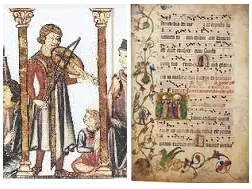
Going back several centuries, here we take a look at how the sheet music survived the middle ages, and played an important role in the growth of music.
Going Back In Time
The latter half of the Middle Ages (circa 1000 CE to 1500 CE) was a turning point in European history. Having finally emerged from the Dark Ages (circa 500 CE to 1000 CE), European civilization finally began to recover the ground it had lost when Rome fell. One of the results of this recovery was the re-emergence of recorded music, or sheet music in both religious and secular life.
Church Realizes the Importance of Music
During the Middle Ages, Catholicism was the central power in Europe. It was incorporated into every aspect of life and its power stretched to every corner of the known world. And one of the methods through which the Church asserted its power was music. Although modern churches regularly use music as a natural part of worship, the pairing of music and Christianity has not always been so straightforward. A thousand years ago, music was often regarded as sinful. Over time, churchgoers tended to enjoy it, and the fathers of Catholicism understood that it could be used to strengthen people’s ties to the Church.
Evolution of Square Notation
Accordingly, music was eventually incorporated into Catholic worship, and vise versa. The sheet music of the era is often adorned with religious frescos. The monasteries and abbeys of the period created and stored huge quantities of sheet music, up to 4000 texts at a time in some cases.
Indeed, it was this mass production of recorded music that led to the evolution of square notation. The monks needed a universal way to record and recognize the music written by their peers in other monasteries; square notation made this possible.
However, church was not the only place a person living in the Middle Ages would hear music, not by a long shot. Also common at the time were wandering poets, or troubadours, who were the keepers and purveyors of secular music. Some of the oldest surviving sheet music was written by these people, who were encouraged in their work by patrons such as Eleanor of Aquitaine.
The area of Provence, modern day southern France, was particularly known for its troubadours, and the region is said to have been known as The Land of Song.
Sheet Music Helps Music Spread
The Church is known to have fought the advent and proliferation of secular music, which it would certainly have regarded as sinful in the extreme. However, fortunately for us, it was unable to stem the music’s spread.
The most popular topic of such secular music was that of courtly love, which may explain why the Church was so against it. Courtly love deals with situations in which lovers are unable to consummate their feelings, usually because one or both is wed to another. This theme is still famous today thanks to the well-known story of King Arthur, Queen Guinevere, and Sir Lancelot. Other popular secular topics included the seasons, the crusades, beautiful women, and nature, all of which were idealized and exalted in song.
Such songs would never have become as ubiquitous as they were, however, without the sheet music produced by the troubadours of the age.
KeytarHQ editorial team includes musicians who write and review products for pianists, keyboardists, guitarists & other musicians. KeytarHQ is the best online resource for information on keyboards, pianos, synths, keytars, guitars and music gear for musicians of all abilities, ages and interests.



Leave a Reply